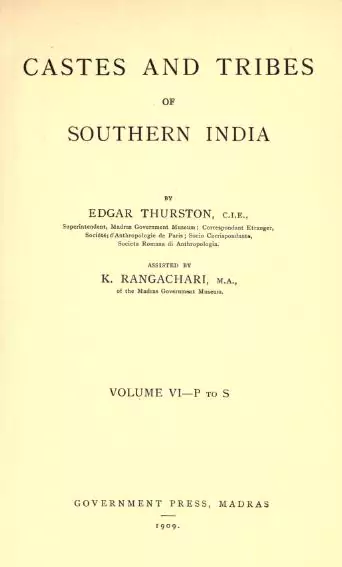‘Castes and Tribes of Southern India’ PDF Quick download link is given at the bottom of this article. You can see the PDF demo, size of the PDF, page numbers, and direct download Free PDF of ‘Castes and Tribes of Southern India’ using the download button.
List Of Castes and Tribes of Southern India PDF Free Download

PKALLI OR VANNIYAN
PKALLI OR VANNIYAN.-Writing concerning this caste the Census Superintendent, 1871, records that “a book has been written by a native to show that the Pallis (Pullies or Vanniar) of the south are descendants of the five races (Agnikulas) of the Kshatriyas and that the Tamil Pullies were at one time the shepherd kings of Egypt.”
At the time of the census, in 1871, a petition was submitted to the Government by representatives of the caste.
Praying that they might be classified as Kshatriyas, and twenty years later, in connection with the census, 1891.
A book entitled Vannikula Vilakkam: A Treatise on the Vanniya caste was compiled by Mr. T. Aiyakannu Nayakar, in support of the caste claim to be returned as Kshatriyas, for details concerning which claim I must refer to the reader to the book itself.
In 1907, a book entitled Varuna Darpanam (Mirror of Castes) was published, in which an attempt was made to connect the caste with the Pallavas.
Kulasekhara, one of the early Travancore kings, and one of the most renowned Alwars reverenced by the Sri Vaishnava community in Southern India is claimed by the Pallis as a king of their caste.
Even now, at the Parthasarathi temple in Triplicane in the city of Madras), which according to inscriptions is a Pallava temple, Pallis celebrate his anniversary with great éclat.
The Pallis of Komalesvaranpettah in the city of Madras has a Kulasekhara Perumal Sabha, which manages the celebration of the anniversary.
The temple has recently been converted at considerable cost into a temple for the great Alwar. A similar celebration is held at the Chintadripettah Adikesava Perumal temple in Madras.
The Pallis have the right to present the most important camphor offering of the Mylapore Siva temple.
They allege that the temple was originally theirs, but by degrees, they lost their hold over it until this bare right was left to them.
Some years ago, there was a dispute concerning the exercise of this right, and the case came before the High Court of Madras, which decided the point at issue in favor of the Pallis.
One of the principal gopuras (pyramidal towers) of the Ekamranatha temple at Big Conjceveram, the ancient capital of the Pallavas, is known as Palligopuram.
The Pallis of that town claim it as their own and repair it from time to time. In like manner, they claim that the founder of the Chidambaram temple, by name Swēta Varman, subsequently known as Hiranya Varman (sixth century A.D.) was a Pallava king.
At Pichavaram, four miles cast of Chidambaram lives a Palli family, which claims to be descended from Hiranya Varman.
A curious ceremony is even now celebrated at the Chidambaram temple, on the steps leading to the central sanctuary.
As soon as the eldest son of this family is married, he and his wife, accompanied by a local Vellala, repair the sacred shrine, and there, amidst crowds of their caste men and others, a homam (sacrificial fire, is raised, and offerings are made to it.
The couple is then anointed with nine different kinds of holy water, and the Vellala places the temple crown on their heads.
| Author | Edgar Thurston |
| Language | English |
| No. of Pages | 524 |
| PDF Size | 25 MB |
| Category | Literature |
| Source/Credits | archive.org |
- Castes and Tribes of Southern India I
- Castes and Tribes of Southern India II
- Castes and Tribes of Southern India III
- Castes and Tribes of Southern India IV
- Castes and Tribes of Southern India V
Castes and Tribes of Southern India Book PDF Free Download
